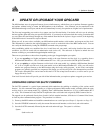
3 - Operation
18 Test Bed Receiver Subsystem Addendum – Rev 1
INITIAL COMMUNICATIONS WITH THE TEST BED RECEIVER
Communicating with the Test Bed Receiver is a straightforward process and is accomplished by issuing desired
commands to the COM1 ports from an external serial communications device. For your initial testing and
communications, you will probably be using either a remote terminal or a personal computer that is directly connected to
a Test Bed Receiver’s serial port by means of a null modem cable.
To change the default communication settings, such as bit rate, use the COMn command, see the MiLLennium Command
Descriptions Manual.
When the Test Bed Receiver is first powered up, no activity information is transmitted from the COMn ports except for
the COM1> prompt described in the Start-Up section above.
Commands are directly input to Test Bed Receiver using the external terminal. It should be noted that most commands
do not echo a response to a command input. Return of the COM1> prompt indicates that the command has actually been
accepted from the Test Bed Receiver. Note that VERSION is the only command that does provide an echo response other
than the port prompt.
Examples:
1. If you type VERSION <Enter> from a terminal, this will cause the Test Bed Receiver to echo the firmware version
information.
2. An example of a no-echo response to an input command is the FIX POSITION command. It can be input as follows:
COM1>fix position 51.113 -114.043 1060 <Enter>
This example illustrates command input to the COM1 port that sets the Test Bed Receiver’s position. However, your
only confirmation that the command was actually accepted is the return of the COM1> prompt.
If a command is erroneously input, the Test Bed Receiver will respond with the “Invalid Command Option” response
followed by the COM1> prompt.


















